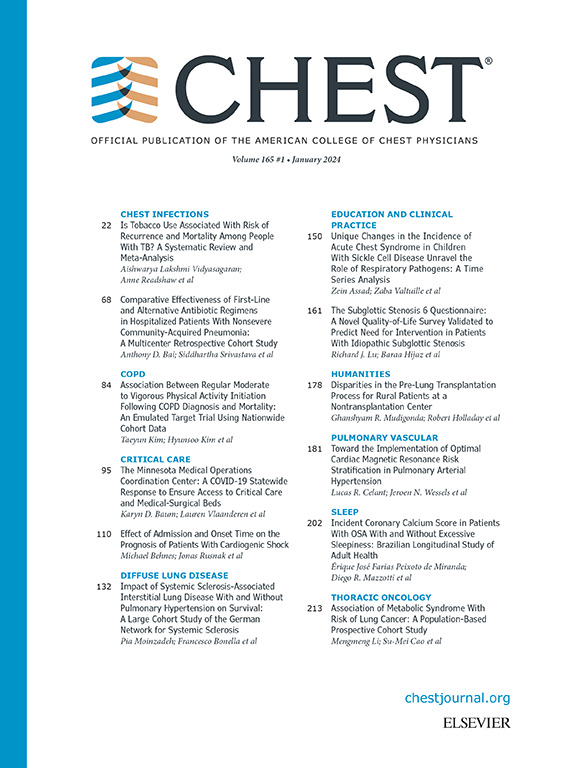Echocardiographic Parameters Enhance Risk Prediction Scores in Pulmonary Arterial Hypertension: Insights from the PVDOMICS Network.
IF 9.5
1区 医学
Q1 CRITICAL CARE MEDICINE
引用次数: 0
Abstract
BACKGROUND Echocardiographic metrics of right ventricular (RV) chamber size and function enhance prognostication, risk stratification, and measurement of therapeutic response in patients with pulmonary arterial hypertension (PAH), though the most effective metrics remain unclear. RESEARCH QUESTION In a well phenotyped cohort of patients with incident and prevalent PAH, can qualitative grades of RV echocardiographic function be established based on their association with functional outcomes, and do they demonstrate prognostic value beyond traditional risk scores? METHODS In the Redefining Pulmonary Hypertension through Pulmonary Vascular Disease Phenomics program (PVDOMICS), 405 (336 prevalent, 69 incident) participants were investigated. Multivariable linear regression examined associations with six-minute walk distance and COMPERA and REVEAL Lite 2.0 PAH risk scores. Penalized Cox Regression was used to develop new models combining prior risk score variables with echo parameters, and cluster analysis combined with survival analysis adjusting for potential confounders to demonstrate prognostic significance. RESULTS In both incident and prevalent PAH, reduced RV function was associated with increased NT-proBNP, reduced six-minute walk distance, and increased COMPERA and REVEAL Lite 2.0 risk scores after adjusting for duration of PAH and relevant confounders. Addition of echocardiographic variables to models incorporating the COMPERA and REVEAL 2.0 scores yielded a 10% increase in the C-statistic compared to either score alone. Mild, moderate, and severe categories of RV dysfunction associated with increased all-cause mortality, with up to a 3.0-fold increase in mortality in multivariable models adjusted for relevant confounders, PAH duration, and invasive pulmonary vascular resistance. INTERPRETATION Reduced RV function on echocardiography in PAH associates with worsened outcomes in incident and prevalent PAH. Echocardiographic assessment of RV function provides additional value to existing PH risk prediction scores and invasive hemodynamics. Furthermore, defining severity of RV function through cluster analysis has important implications for risk prognostication with potential application to monitor response to therapy.超声心动图参数提高肺动脉高压的风险预测评分:来自PVDOMICS网络的见解。
背景右心室(RV)腔大小和功能的超声心动图指标可增强肺动脉高压(PAH)患者的预后、风险分层和治疗反应测量,但最有效的指标仍不明确。研究问题在一个表型良好的发病和流行性 PAH 患者队列中,能否根据 RV 超声心动图功能与功能结果的关联确定 RV 功能的定性等级,以及它们是否具有超越传统风险评分的预后价值?方法在 "通过肺血管疾病表型重新定义肺动脉高压 "项目(PVDOMICS)中,对 405 名参与者(336 名流行性患者,69 名发病患者)进行了调查。多变量线性回归检验了六分钟步行距离与 COMPERA 和 REVEAL Lite 2.0 PAH 风险评分之间的关系。结果 在事件性和流行性 PAH 中,RV 功能降低与 NT-proBNP 增加、六分钟步行距离缩短以及调整 PAH 持续时间和相关混杂因素后的 COMPERA 和 REVEAL Lite 2.0 风险评分增加有关。在包含 COMPERA 和 REVEAL 2.0 评分的模型中加入超声心动图变量后,C 统计量比单独使用其中一个评分时增加了 10%。轻度、中度和重度 RV 功能障碍类别与全因死亡率增加有关,在调整了相关混杂因素、PAH 持续时间和侵入性肺血管阻力的多变量模型中,死亡率最高增加了 3.0 倍。超声心动图对 RV 功能的评估为现有的 PH 风险预测评分和有创血流动力学检查提供了额外的价值。此外,通过聚类分析确定 RV 功能的严重程度对风险预后具有重要意义,并有可能应用于监测对治疗的反应。
本文章由计算机程序翻译,如有差异,请以英文原文为准。
求助全文
约1分钟内获得全文
求助全文
来源期刊

Chest
医学-呼吸系统
CiteScore
13.70
自引率
3.10%
发文量
3369
审稿时长
15 days
期刊介绍:
At CHEST, our mission is to revolutionize patient care through the collaboration of multidisciplinary clinicians in the fields of pulmonary, critical care, and sleep medicine. We achieve this by publishing cutting-edge clinical research that addresses current challenges and brings forth future advancements. To enhance understanding in a rapidly evolving field, CHEST also features review articles, commentaries, and facilitates discussions on emerging controversies. We place great emphasis on scientific rigor, employing a rigorous peer review process, and ensuring all accepted content is published online within two weeks.
 求助内容:
求助内容: 应助结果提醒方式:
应助结果提醒方式:


